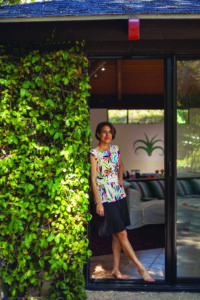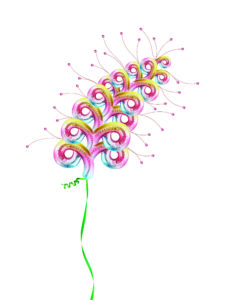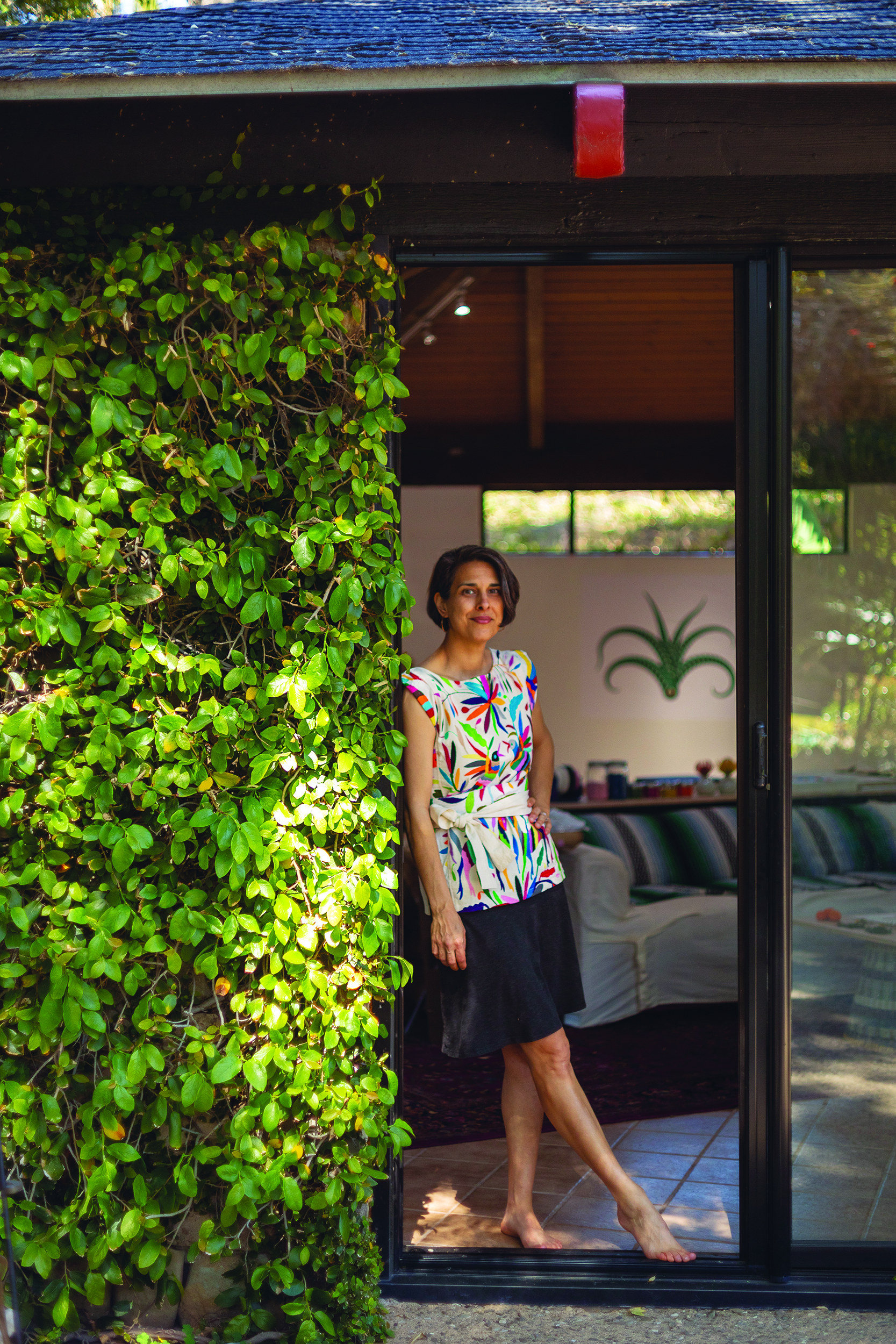FEATURES | By Ellen Sklarz
Cassandra Jones at Taft Gardens

Cassandra Jones at Taft Gardens
Throughout history, human beings have yearned to create, often inspired by nature. From the cave paintings of Lascaux to the ephemeral, performative sculptures of Andy Goldsworthy, artists have observed, engaged, and used the earth’s natural elements to create their works.
The glorious, imposing beauty of the Ojai Valley’s land, skies and wildlife offer boundless inspiration for those like contemporary artist Cassandra C. Jones, who moved to the valley in 2012 with her husband, musician Mikael Jorgensen.
Six years ago, Jones discovered Taft Gardens and Nature Preserve while tagging along with Jorgensen, who was scouting for a location to shoot a music video. As they toured the property, Jones found an enormous seed pod on the ground that had fallen from an Australian Banksia tree. “It was a deep-gray color, oblong in shape, hairy, and covered end to end with what I could only describe as Muppet mouths,” recounts Jones.
“It seemed alien, and I was enchanted. I had not been on the grounds for more than 20 minutes before I thought, ‘I have to do a project here someday.’ “
Jaide Whitman, whose parents are hotelier Julia and architect Marc, grew up on the land adjacent to the storied 264-acre gardens established by her conservationist grandfather, her beloved “Opa,” John Taft. After graduating from university and traveling, she has come back home to Ojai. Whitman is currently president of the board of the Conservation Endowment Fund (CEF), the nonprofit that operates the garden, founded by Taft in 1981. She quietly embraces the gravity of her position as a steward of the land and her family’s legacy.
Whitman guides visitors throughout the gardens, explaining that in the past several years, “I’ve been becoming more involved to reinvigorate, not only the organization but also the land.
Obviously, this is my grandfather’s creation . . . he’s the visionary here. But the organization needed a new vision, a new direction and someone to lead. I stepped in and have had a wonderful time with my Opa. Since we’ve have been working together, he is as energetic and clear as ever. It’s all been really rewarding and so joyful for everyone.”
This past January, amid an incomparable year, CEF announced the creation of the Taft Gardens Art in Nature, Artist-in-Residence Program, and invited Jones to launch the series.
As the staff renovated a historic studio where artists could work, a newly formed arts board conceptualized how the residency would integrate with community engagement. Says Whitman,
“The Artist-in-Residence program came very naturally as we have these spaces that have been searching for their purpose for the past 10 years. With Cassandra, we have a very synergistic relationship where her vision for her art mirrored our vision for how we wanted the space to be used. What this has done for us it to allow us to launch a program that empowers our local artists, and we do hope to continue to invite more artists into the residency as it grows.”
Jones refers to herself as a digital collage artist and storyteller. She uses photography clippings, creating large-scale compositions in Photoshop with thousands of layers. These often end up as wallpaper installations, prints with small editions, and videos. Her work reflects a technology-based, often-self-absorbed, modern culture and her personal experience within that.
As her residency progressed, Jones drew inspiration from the extraordinary gardens, surrounding nature preserve, and magic of the land. From a post-Thomas Fire and post-pandemic perspective, her relationship to nature felt more visceral and complex. In the studio, she developed a botanical series based on the flora of the South African and Australian gardens, using digital photo-collage to reimagine various plants in the style she has become known for since 2004. Visitors were encouraged to stop by — at a well-respected social distance —to see her progress and hear her story.
After the massive, month-long 2017 wildfire swept through the Ojai Valley, Jones’ house, family, and extended family were safe. However, after returning home from evacuation, she was overwhelmed by the toxicity in the air, which remained unsafe for several weeks. In her lucid, reflective artist’s statement, Jones says: “All the modern-day conveniences, technologies, and synthetics of our time, in all those houses, melted. They turned to acidic embers, harmful gases, and nanoplastics, and then they rose into the air, swirling in great plumes. When they reached as high as they could go up in the atmosphere, they gently floated down onto our landscape as the softest and smallest of relics.”
With much time spent indoors, Jones would look outside at the surrounding mountains, covered in ash. She deliberated and watched, saddened by the knowledge that the ash contained fragments of the possessions of those who lost their homes. Those particles, she realized, would now become part of the natural world and new growth for hundreds or thousands of years.
Scientists worldwide are finding that we have dusted significant portions of our planet, from land to sea, with micro- and nanoplastics. They are present in the wildest landscapes and the most manicured gardens. While the research is new, it is becoming clear that these tiny particles can accumulate in the tissue of plants. With that understanding, Jones spent her time at Taft Gardens portraying specimens from nature, infused with the stuff of humans.
 She re-created a barrel cactus using photographs of beachballs, pincushion flowers (Leucospermum) from Mardi Gras beads and slinkies, and spider flowers (Grevillea) from sherbet-colored birthday balloons.
She re-created a barrel cactus using photographs of beachballs, pincushion flowers (Leucospermum) from Mardi Gras beads and slinkies, and spider flowers (Grevillea) from sherbet-colored birthday balloons.
Although plastic was initially considered a miracle material that made modern life possible, single-use disposables might not be the only culprit. Jones wonders about all the additional “consumerist items we use to celebrate, amuse and express ourselves as humans. What about the party supplies, games, toys, fashion, furniture, etc., I am most interested in these particular objects because they play small yet essential parts in shaping our identities and desires. And while they have limited lifespans and most often can never be recycled, because of their potency, they don’t seem so sinister.”
Jones reflects on local and global ambiance after the first lockdown. Most everywhere, the animal world became healthier and


Leave A Comment